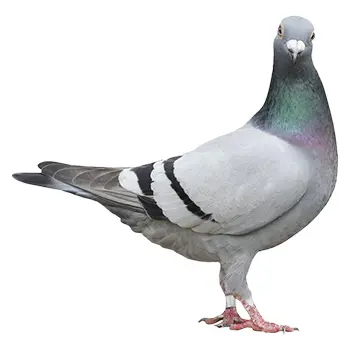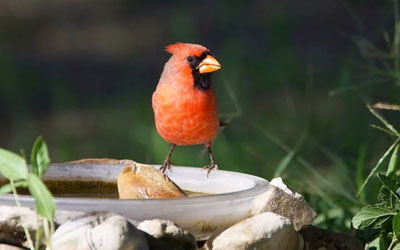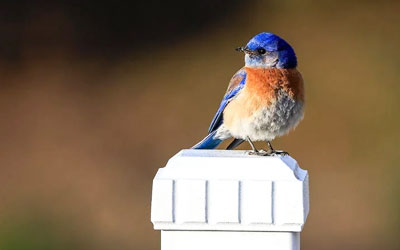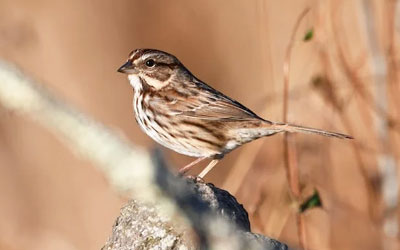Bird Control
Peachtree Pest Control does not offer Carcass & Dead Animal Removal. Animal removal is only completed by our team when an animal is found in a wildlife trap. Please contact your municipal office for local animal removal vendors.
Birds are a natural part of our ecosystem and most make a bird-watcher’s pastime worthwhile. However, there are some bird species considered pests around your home or business, and if this is the case, it’s important to learn which are pest birds. To protect your home or business from pest birds, you need to learn about the behavior of this pest, take steps for prevention, and find effective treatment options should an infestation occur.

Which Birds Are Considered Pests?
Bird control experts at Bird Doctor explain that over 1,000 different species of birds reside in the U.S. While bird-watching enthusiasts and conservation efforts suggest that most birds are highly valued, some species are considered pest birds due to their detrimental impact on property and local ecosystems throughout Atlanta, Augusta, Fayetteville, Woodstock, Suwanee, Marietta, Hiram, and Aiken SC.
National, state, and local regulations protect many migratory birds throughout the U.S. However, birds commonly seen as pests in Atlanta, Augusta, Fayetteville, Woodstock, Suwanee, Marietta, Hiram, and Aiken SC, are usually invasive species, and therefore not protected by national ordinances. These pest birds are the most common subjects of our bird control products and services. These usually include:
Northern Cardinal:

Northern Cardinals are very common in Georgia. They’re easily identifiable as well, with the male being a bright red with black surrounding their orange beaks. Females on the other hand are grayish-brown, and have reddish orange wings, tails, and beaks.
Eastern Bluebird:

The Eastern Bluebird is very commonly seen throughout the year in Georgia. They have a big, round head and a plump body. They can be easily identified by their blue heads and wings.
Chipping Sparrow:

The Chipping Sparrow is seen through Georgia all throughout the year. Those in south Georgia may see the Chipping Sparrow more during the fall and winter times. The Chipping Sparrow has gray breasts, a black line going through their eye, and a reddish-brown cap.
Migratory Birds and Woodpeckers
Disclaimer
Migratory birds, including woodpeckers, are protected under Federal Law under the Migratory Bird Treaty Act. Due to their protection, Peachtree Pest Control cannot complete any bird control service for migratory birds. For more information regarding their protection, please visit https://www.fws.gov/birds/policies-and-regulations/laws-legislations/migratory-bird-treaty-act.php
How Do I Prevent Invasive Birds From Becoming Pests in My Home or Business?
Some preventive bird control measures can stop these animals from becoming a problem in your home or business. Like all birds, Northern cardinals, eastern bluebirds, and Chipping sparrows gravitate toward ready food sources. Therefore, the best way to prevent them from taking over your home or business is to avoid making their preferred meals available. Keep garbage impossible to access in lidded containers. If you have bird feeders around your yard in order to attract local bird species, limit them to food that only the native species eat. Avoid common commercial birdseed mixtures that include cracked corn, sunflower seeds, and suet.
Bird control experts at Bird Doctor recommend discouraging pest birds by limiting nesting areas that they’d like. Keep sheds and garages closed, and seal up birdhouses that you might have during the migratory season. Bird control experts at Bird Doctor reveal most pest birds don’t migrate and therefore tend to grab nesting places before native, migratory birds return to the nest.
What Are the Effects of Pest Birds Around My Home and Business Throughout Atlanta, Augusta, Fayetteville, Woodstock, Suwanee, Marietta, Hiram, and Aiken SC?
Bird control experts at Bird Doctor say a few birds around your home or business may seem innocuous at first; however, the potential damage to your property and health could be significant. Here are some ways that bird pests can impact your home or business and require bird control services.
Health:
Some birds are huge carriers of disease, most commonly encephalitis and salmonella. When inhaled, pigeon waste can trigger sicknesses like cryptococcosis, histoplasmosis, and psittacosis. Pigeons can also carry additional pests, including fleas, ticks, and lice.
Damage to Property:
In addition to health concerns, a heavy bird population can cause significant damage to property. Nests may block important ventilation, bird droppings can permanently damage finished surfaces on homes and cars, and birds can also contaminate livestock food and water or damage crops.
Environmental Impact:
One of the biggest ways that bird pests affect your home is they crowd out native species. Since these birds don’t migrate, they have an advantage come nesting season, and they tend to flock in bigger numbers than native songbirds. Northern cardinals, eastern bluebirds, and Chipping sparrows all have had a monumental impact on native ecosystems, from local birds’ nesting and feeding patterns to the balance of insect populations. Bird control experts emphasize starlings are especially considered highly aggressive toward native species in Atlanta, Augusta, Fayetteville, Woodstock, Suwanee, Marietta, Hiram, and Aiken SC.
Disturbance:
Bird control experts at Bird Doctor say birds can cause significant disturbance when nesting in residential areas. The most frequent complaint known is about noisy starlings, which tend to congregate in loud, large flocks throughout the winter. Even quieter birds can cause a noise disturbance when they nest or roost within the vents of a home or business.
What Are the Lifecycles and Habits of Cardinals, Orioles, and Bluebirds?
Habits and behavior of bird pests vary across species, and so it’s essential to understand what kind of bird you’re dealing with in order to understand how to strategically enact effective bird control. Learn more about the habits of the most common breeds of pest birds below in Atlanta, Augusta, Fayetteville, Woodstock, Suwanee, Marietta, Hiram, and Aiken SC.
Northern Cardinals:
Northern Cardinals live between 3-5 years. They usually raise two broods each year. They mate in March and from May – July. They feed on insects and seeds.
Eastern Bluebird:
Eastern Bluebirds live between 6-10 years. They typically raise two or three broods per year. They mate from February – July. They feed on insects and berries.
Chipping Sparrows:
Chipping Sparrows have a variable lifespan. Some live less than a year, while others can live upwards to 10 years. They raise between 1-3 broods every year. They mate from April – July. They feed on insects and seeds.
What if a Protected Bird Has Become a Pest on My Property?
Although this article focuses primarily on species that cause the most pest problems throughout Atlanta, Augusta, Fayetteville, Woodstock, Suwanee, Marietta, Hiram, and Aiken SC, there are undeniably other species that can be a huge hassle for homeowners and business owners. Bird control services are especially necessary if you have a bird incident in which birds have created a nest within your home and office building.
Other species that may cause problems include crows, seagulls, and grackles. This is when a thorough understanding of bird behavior and habits becomes such an asset. Peachtree Pest exercises methods of bird control that have a positive effect on local ecosystems and it carefully maintains state, federal, and local guidelines for population control.
If you have questions about which species of birds are protected, you can view the U.S. Fish and Wildlife Service’s full list of in-danger species.
Will There Be a Disruption to My Business or Home During Bird Control?
Different cases call for varying levels of care, some of which may require ladders and construction materials on-site. For example, if there’s a problem with nesting and roosting within your building’s rafters or air ducts, it may be best to approach and evaluate the situation from the inside as well as outside access points. However, our bird control technicians at Bird Doctor are specially trained to use an effective, minimally disruptive methodology and conduct themselves with the utmost consideration for our customers. Our schedule will be based on your needs in order to cause as little disruption to your day as possible.
Do Fake Owls and Other Visual Deterrents Work for Preventing Birds?
Fake owls can work effectively to deter birds, but only temporarily. In fact, anything newly introduced to an environment causes birds to be cautious, whether you hang streamers or start playing music from a stereo. However, birds quickly adapt to the situation and resume their usual behavior as soon as they notice that the new deterrents never move or act.
Does Peachtree Pest Control’s Bird Doctor Offer a Work Guarantee for Bird Control?
We do indeed. We have the utmost confidence in our bird control services, which is why we offer a no-cost re-treatment visit if our bird control isn’t effective the first time. This guarantee applies to both services rendered and materials used. Our job isn’t done until your pest problem is completely resolved. Call or schedule online a FREE ESTIMATE today!
Does Peachtree Pest Control’s Bird Doctor Follow OSHA Safety Standards?
Absolutely. Our pest control technicians undergo regular mandatory safety training and adhere to a strict code of conduct. We know that bird control scenarios can sometimes become unpredictable, so our personnel wear safety gear and take appropriate safety measures at all times.

Protecting Your Home or Business From Bird Control With Peachtree Pest Control
Peachtree Pest Control offers expert treatment designed to effectively and efficiently control and prevent pests from invading your home or business in Atlanta, Augusta, Fayetteville, Woodstock, Suwanee, Marietta, Hiram, and Aiken SC. Our use of Integrated Pest Management (IPM) techniques focuses on finding the core of the pest concern and controlling Bird Control from the source. Through IPM, pest control materials are selected and applied in a manner that minimizes risks to human health, pets, and the environment.
Call Peachtree Pest Control today for your FREE and NO OBLIGATION estimate at 855-732-2487 or Schedule Online today!






